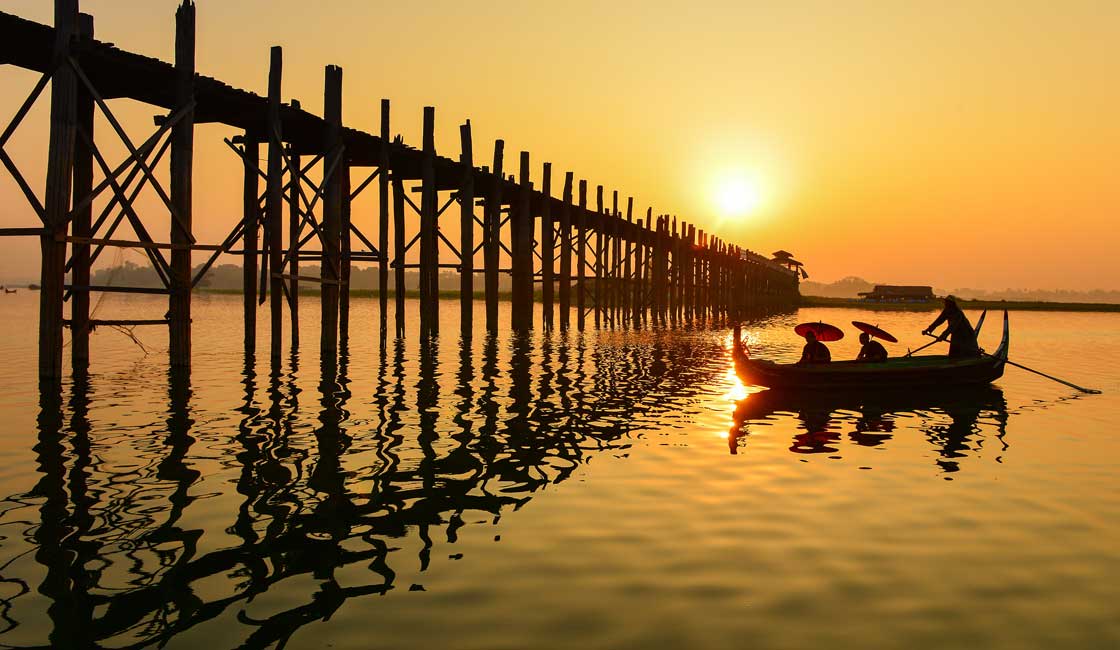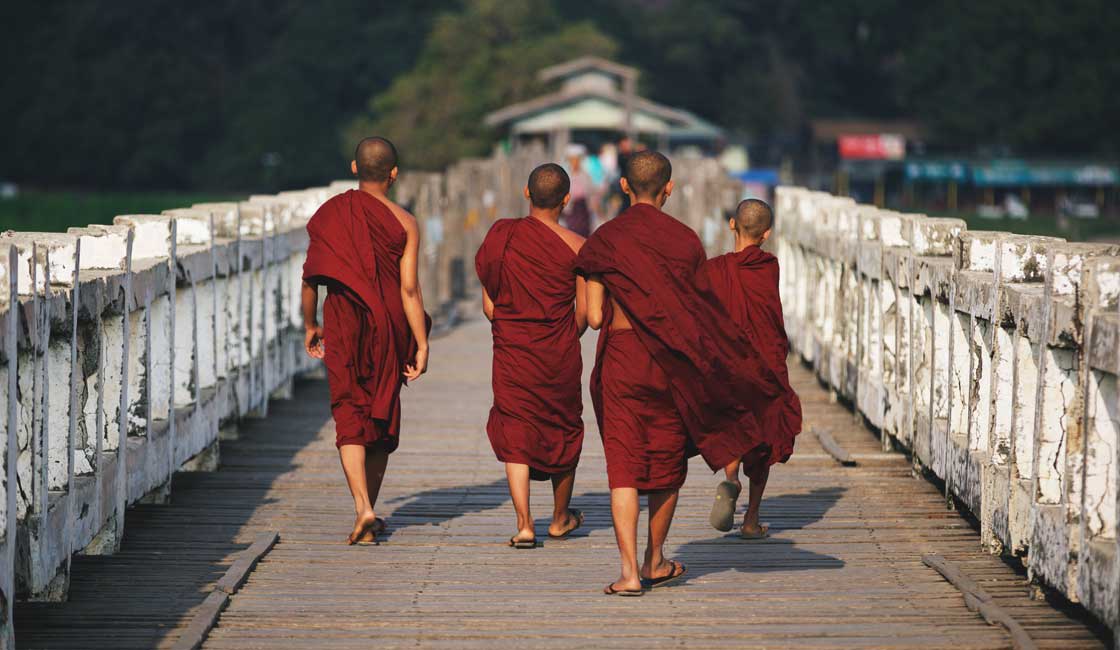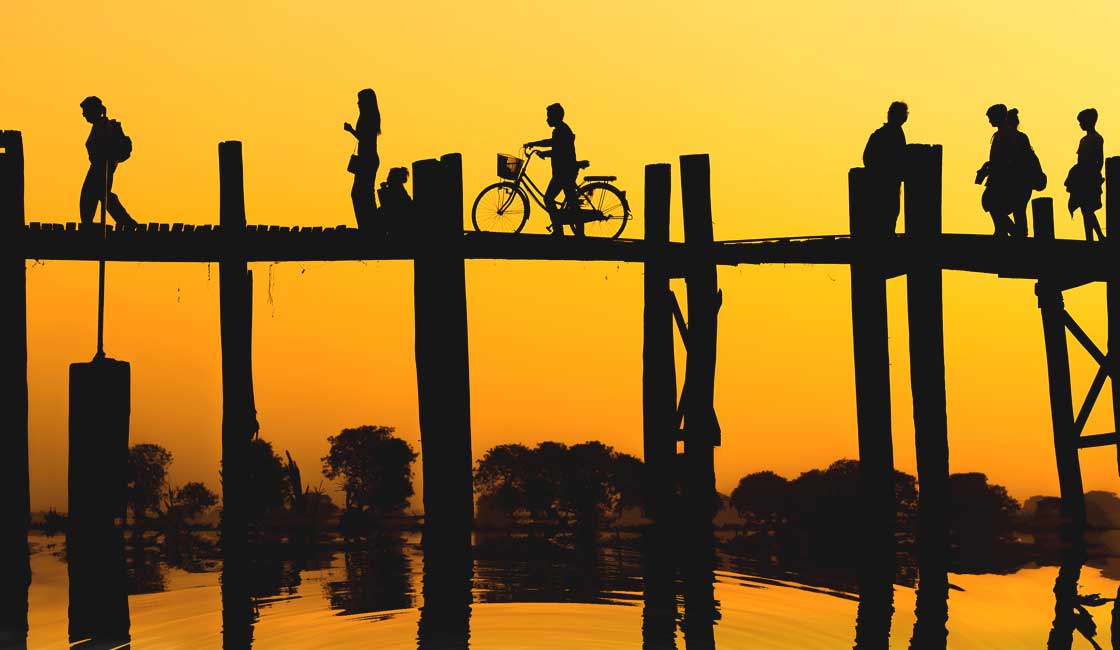
The beautiful U-Bein bridge is easily one of Myanmar’s most photographed and iconic sites. With its picturesque structure, bustling local life and legendary sunsets, it’s fast becoming one of the country’s premier tourist attractions. Here are the basics you need to know if you’re planning a visit to this unique and mesmerizing teak bridge.
U Bein is the world’s longest and oldest teak bridge, straddling 1.2 kilometers across the shallow waters of Taungthaman Lake. It consists of a rickety walkway, accessible to pedestrians and cyclists only, along with four covered pavilions and is supported by over 1,000 wooden posts hammered into the lakebed. The bridge is around 150 years old and was constructed entirely out of timber reclaimed from a nearby royal palace that was razed when Myanmar’s capital moved to Mandalay in 1857. Amazingly, the majority of the structure remains intact and sturdy in its original construction – just a small handful of poles have needed to be replaced by concrete supports. The bridge is named after mayor U Bein who salvaged the teak remains and spearheaded its construction.
The bridge is located in Amarapura, a former Burmese capital, which is situated just 11km south of Mandalay. There are a whole host of different ways to access the site from Mandalay, the most popular being to hire a taxi which will take you there and back for around $10. Alternatively, a cheaper option is to take a motorbike taxi for $3 or to take a 30-minute ride on the local bus for less than $1. You can also organize a guided tour from Mandalay, with the price of a taxi included, or pick up a guide once you’re at the bridge.

Monks in typical burgundy robes
One of the most enchanting aspects of the bridge is that it continues to play a central role in community life. Strolling its rickety walkway means not only enjoying the wonderful scenery, but also plenty of chance to observe and get immersed in the local life. U Bein remains fairly busy all day, but comes especially alive at dawn and sunset when it attracts endless streams of people going about their daily commute and various activities. Hundreds of people of all types pass by, including monks, school children, cyclists, fishermen hauling in their catch in the surrounding waters, as well as plenty of tourists and hawkers too. You’ll find spending time on the bridge is a great way to get chatting to the locals. Many of the monks and youngsters, in particular, are keen to strike up a conversation and practice their English with you as they cross.
Take to the water to gain a different and ever-changing perspective on the bridge. Hordes of rowing are available for hire from the lakeshore and their owners will happily transport you from one end to the other, making sure to stop at the best positions so you can capture some captivating shots. During the winter dry season, the bridge looks and feels quite high. Its long poles are exposed and the lake is surrounded by seasonal vegetable gardens. In contrast, the wet season sees the lake expand significantly with water levels lapping just below the bridge planks. In high season, and especially in July/August, it can get pretty busy so you may need to arrive early to find a free boatman and also come prepared to barter down some of the prices.
As a growing tourist destination, U Bein is home to plenty of hawker stalls, particularly along the western bank. Spend some time shopping in the souvenir markets which are filled with wood carvings, local jade jewelry and interesting art pieces. There are also plenty of cafes for sampling some local nibbles, as well as several larger eateries where you can enjoy a relaxing sit-down meal at the end of your walk.
Within easy reach of the bridge, there are a couple of worthwhile religious sites well worth paying a visit. On the Amarapura side, Taunthaman village is home to the exquisite Kyuaktawgyi pagoda, which was built in a similar style to the temples at Bagan, aside from its striking Tibetan roof. Near the bridge, you’ll also find the Mahagandayon Monastery where every morning hundreds of saffron-robed monks file out its doors.

Sunset at U-Bein Bridge
Last, but certainly not least, it’s definitely worth staying to witness the spectacular sunset. The bridge becomes especially busy towards the end of each day as locals make their way home and tourists venture out eager to capture perfect silhouettes against the blazing and ever-changing colors of the sky. The best perspective and camera shots are to be had from renting out a boat and approaching the bridge from a low angle. The sunrise is also well worth catching as the bridge is generally less crowded in the early hours and the atmosphere more tranquil.
While Rainforest Cruises aim to provide accurate and up-to-date information, we make no representations as to the accuracy or completeness of any information herein or found by following any link on this site. Rainforest Cruises cannot and will not accept responsibility for any omissions or inaccuracies, or for any consequences arising therefrom, including any losses, injuries, or damages resulting from the display or use of this information.




